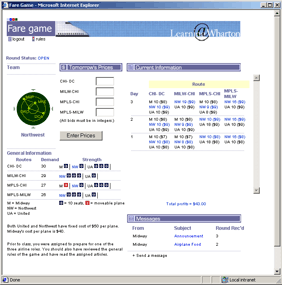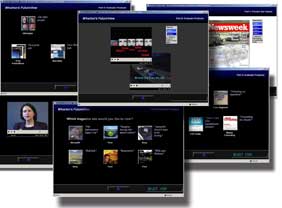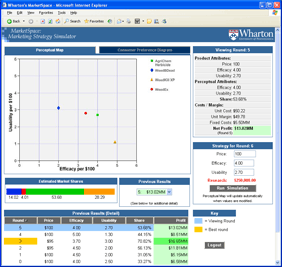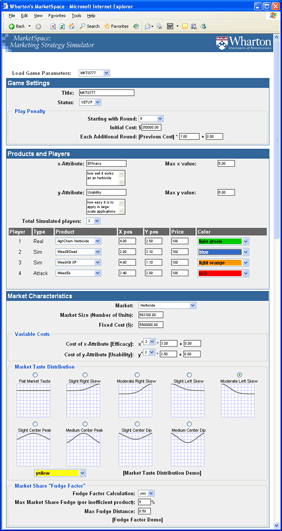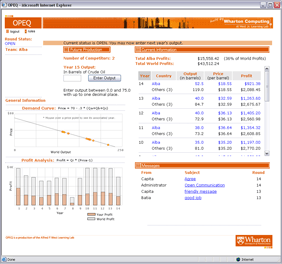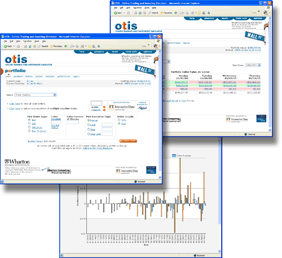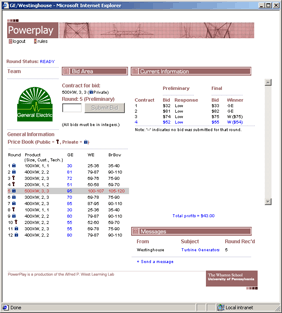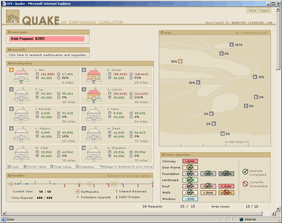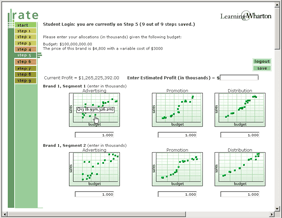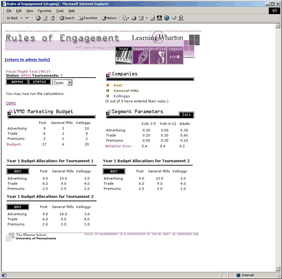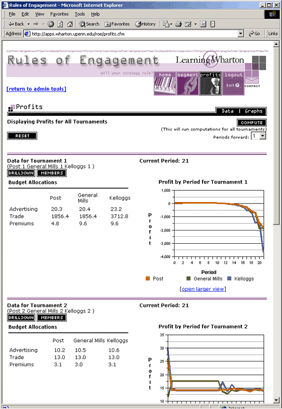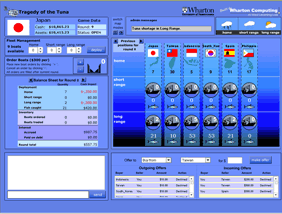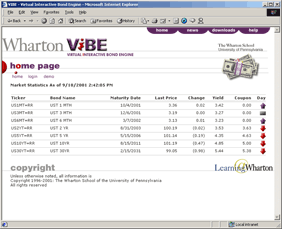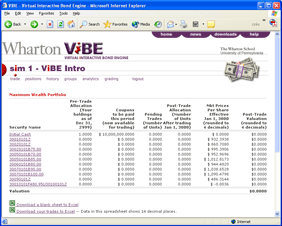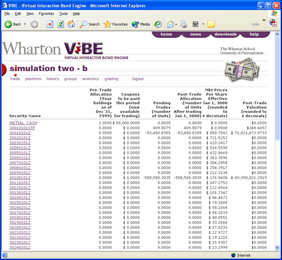Below is a selection of the learning simulations developed by Wharton's Alfred West Jr. Learning Lab. For additional information and more details on the simulations, see the Learning Lab's Web site at http://www.wharton.upenn.edu/learning/.
Fare Game
Modeled after the air fare competition that emerged from Midway Airline's aggressive entry into the Milwaukee market in 1989, Fare Game places students in a mock "fare war" to demonstrate how airlines can compete or cooperate using fare cuts and hikes. Through price-setting and resource allocation, students learn how to keep their company profitable, keep investors content, and "signal" to other competitors in the marketplace.
Image: Fare Game, main interface
FutureView
Wharton's FutureView presents a rich, Web-based multimedia environment that demonstrates how "information acceleration" can be used to develop quantitative marketing data for entirely new categories of products.
Image: Montage of screens from FutureView
MarketSpace
Wharton's MarketSpace puts students in the role of product managers responding to a new competitor entering the marketplace. During the first phase of the exercise students must find an effective counter strategy to reposition their product in response to the competitive market entrant.
In the classroom, the instructor can use MarketSpace to extend the exercise to show the impact of a competitor's response to the student's position and to demonstrate the tradeoffs of various strategies.
Image: MarketSpace, main student interface
Like most Wharton Learning Lab simulations, MarketSpace allows the instructor to configure a wide range of settings to create different scenarios. In MarketSpace, the names and type of products, their market positions, the overall size of the market, the cost of modifying the attributes of the player's product, the market taste distribution, and even a "fudge factor" to model market inefficiencies can be configured by the faculty member.
Image: MarketSpace faculty administrative configuration screen
OPEQ
Wharton's Oil Pricing EQuilibrium (OPEQ) is used in negotiations courses to teach negotiating strategies involving shared resources and incomplete information. OPEQ demonstrates principles of individual versus overall profit levels and ways of responding to competitors in a closed market.
Image: OPEQ, main interface
OTIS
Wharton's Online Trading and Investment Simulator (OTIS) allows student fund managers to buy and sell securities ranging from domestic and international equities to options and future contracts using real data from today's markets. OTIS tracks a wide range of securities, keeping real-time data on positions, values, histories, and dividends.
Working with OTIS, students learn concepts such as portfolio balancing and management, benchmarking, and the impact of large-scale fund buys and sells on market positions.
Image: Montage of screens from OTIS
Power Play
In Power Play students assume the roles of companies competitively bidding for a series of procurement contracts for large-scale power generators. Each contract has a two-bid cycle. During the first round, students bid and then receive feedback on whether their bid was successful against their competition. They must then decide on a final bid based on private information about their production costs, partial information about the competitor's cost structure, and the feedback from their initial bid.
Image: Power Play interface
Quake
Quake is a Web-based earthquake simulator that teaches how individuals make decisions with respect to low-probability, high-consequence events. In the simulation players own a home with a fixed starting value and can pay to invest in measures that lower the risk of damage caused by earthquakes. As the game advances, earthquakes of differing magnitudes occur and may cause damage to the homes. Each player's goal is to make mitigation investment decisions to maximize the value of their assets at the end of the game.
Image: Quake, main interface
RATE
In the real world, decisions about marketing allocations can seriously affect profit levels. To prepare students to make these decisions, Resource Allocation Teaching Environment (RATE) provides realistic scenarios providing practical, hands-on experience in a virtual market.
Image: RATE, setting marketing allocations for a product
Rules of Engagement
Rules of Engagement allows students to explore different ways to demonstrate the intricacies of game theory when played in an iterative, competitive space. In this application, students assume the role of major breakfast cereal manufacturers, set "rules" that will govern future marketing expenditures, and watch as their plans unfold and the competition responds.
Image: Rules of Engagement, main student interface
The application allows the professor to simulate the effect of the strategies over a long time period, so the students can see how their strategies play out over time. The administration module also allows professors to display results, drill down through a specific scenario, roll back the simulation to an earlier state, and conduct hypothetical scenarios.
Image: Rules of Engagement, faculty administrative interface, which allows the instructor to display results and run additional simulations with modified sets of rules
Tragedy of the Tuna
Based on Garret Hardin's 1968 paper "The Tragedy of the Commons," this simulation explores the notion that any resource that is open to everyone—such as the air or parts of the ocean—will eventually be destroyed because everyone can use the resource but no one is responsible for preserving it. In the Learning Lab's Tragedy of the Tuna each student (or team of students) is a country in control of a tuna fishing fleet and must make decisions about size and deployment of their fleet. As the game progresses, teams vie to stay afloat as competition for the shared fish population becomes more intense.
Image: Tragedy of the Tuna, main interface.
VIBE
Wharton's Virtual Interactive Bond Engine (VIBE) allows students to build portfolios by taking long or short positions from a universe of bonds. A sequence of exercises requires students to design portfolios with different performance goals. As virtual time passes in the simulation, the effects of interest rate changes are automatically calculated. Students can view the performance of their portfolios relative to other students.
Image: VIBE opening screen, showing current market conditions
Image: VIBE screen showing history of trades in the first simulation
Image: VIBE screen showing history of trades in the second simulation

